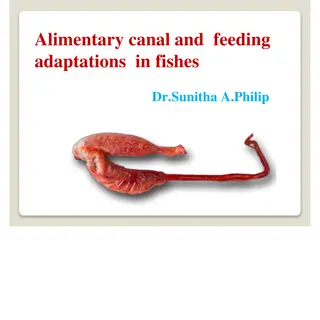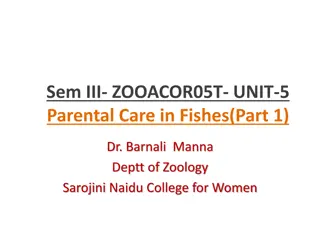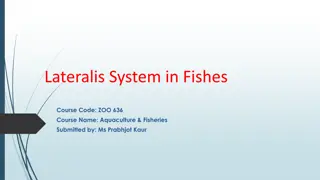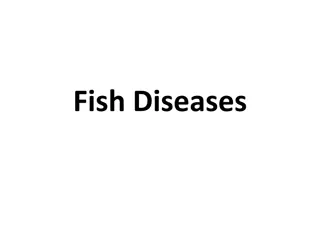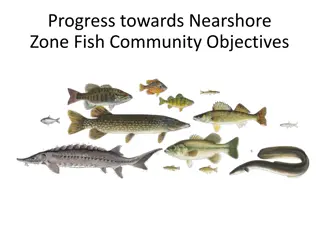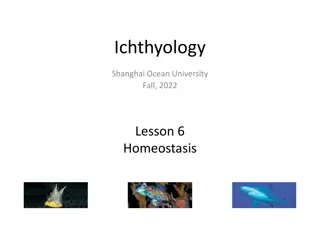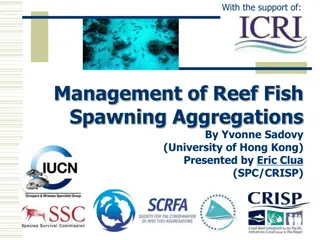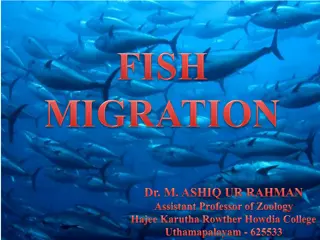Understanding the Fascinating World of Fishes: A Comprehensive Overview
Fishes, the most numerous vertebrates on Earth, exhibit incredible diversity across various groups such as Agnatha, Chondrichthyes, and Osteichthyes. From jawless Agnatha like lampreys to bony Osteichthyes including lobe-finned and ray-finned species, fishes display unique characteristics and adapta
6 views • 8 slides
Understanding the Positive and Negative Aspects of Fishes
Dr. Mohammad Hamed Bahnasawy, a Professor of fish biology, discusses the positive aspects like diversity and importance of fishes, alongside the negative aspects such as poisonous and venomous fishes, highlighting toxins present in different fish species and risks associated with consumption.
2 views • 28 slides
Alimentary Canal and Feeding Adaptations in Fishes by Dr. Sunitha A. Philip
The presentation discusses the alimentary canal and feeding adaptations in fishes, covering topics like the different regions of the gut, mouth types in fish, adaptation of teeth for specific diets, and the roles of the buccal cavity, pharynx, and gill rakers. It further explores how gill rakers var
0 views • 24 slides
Overview of Lymphoid Organs in Finfish and Shellfish
Lymphoid organs play a crucial role in the defense mechanisms of finfish and shellfish by generating immune cells. Different types of fish vary in their lymphoid organ structures, with jawless fish relying on lymphoid tissue within other organs for immune cell production. Cyclostomes, like hagfish a
1 views • 24 slides
Parental Care in Fishes: Importance and Diversity
Parental care in fishes is an instinctive behavior that ensures offspring survival and reproductive success. It can be provided by males, females, or both parents, with different types of care strategies such as maternal care, biparental care, and various methods of protecting eggs and young. The co
2 views • 19 slides
Understanding the Lateral Line System in Fishes for Aquaculture & Fisheries
The lateral line system in fishes is a crucial sensory organ that helps in adjusting to water conditions. It comprises the lateral line canal and neuromast organs, providing sensitivity to water currents and pressure. Specializations in different fish groups like sharks and teleosts showcase variati
7 views • 7 slides
Comparative Analysis of Vertebrate Brains: From Cartilaginous Fish to Amphibians
The brain in vertebrates varies in size and complexity, with distinct structures like the prosencephalon and mesencephalon. From cartilaginous fishes with large olfactory lobes to bony fishes with specialized brains, the evolution of brain structures can be observed. Amphibians, like frogs, show uni
1 views • 12 slides
Freshwater Edible Fishes: A Culinary Delight
Freshwater fishes are a valuable food source in tropical regions. With high protein content, essential nutrients, and great taste, popular varieties like Labeo Rohita, Catla Catla, and Cirrhinus Mrigala offer a delicious and nutritious culinary experience. Learn about their characteristics, breeding
0 views • 31 slides
Composite Fish Farming: An Innovative Aquaculture Technique
Composite fish farming is a popular aquaculture technique where different compatible fish species are cultured together in ponds to maximize fish production. Researchers from India and abroad have contributed significantly to this field. The practice involves combining Indian major carps like Catla,
1 views • 19 slides
Understanding Fish Diseases and Health
Fish diseases and health are essential aspects of aquatic life. Diseases can be infectious or non-infectious, causing impairments to the normal state of fishes. Recognizing symptoms and signs of diseases is crucial for diagnosis and treatment. Overall, maintaining the health of fishes is vital for t
0 views • 21 slides
Exploring Hakaluki Haor: A Lesson on Biodiversity and Economic Importance
Dive into the breathtaking world of Hakaluki Haor with this educational presentation. Learn about the unique biodiversity, economic significance, and ecological importance of this wetland in Bangladesh. Discover the different kinds of fishes and birds that call Hakaluki Haor their home, and expand y
3 views • 39 slides
Progress Towards Nearshore Zone Fish Community Objectives
Protect, restore, and sustain the diversity of the nearshore fish community, emphasizing self-sustaining native fishes such as Walleye, Yellow Perch, Lake Sturgeon, Smallmouth Bass, Largemouth Bass, sunfish, Northern Pike, Muskellunge, Round Whitefish, and American Eel. Goals include maintaining hea
0 views • 10 slides
Ecological Indicators for Coastal Estuary Habitat Analysis
Explore conceptual frameworks and models for developing indicator lists in the coastal estuary habitats of Washington, focusing on key components like intertidal zones, shorebirds, fishes, and more. Dive into the connections within food webs, physical drivers, climate change impacts, and weather ele
0 views • 12 slides
Insights into Fish Physiology and Thermal Regulation
Exploring the intricate mechanisms of fish physiology, particularly focusing on the autonomic nervous system's role in controlling internal organ functions and maintaining homeostasis. Additionally, delving into how fishes manage thermal regulation and optimize body temperature for growth, feeding,
0 views • 20 slides
Research Contributions of Professor Ole Kristian Berg in Fish Ecology and Aquaculture
Professor Ole Kristian Berg from the Department of Biology at NTNU has made significant contributions to the fields of fish ecology and aquaculture. His research focuses on topics such as biotic interactions, competitive asymmetries, conservation biology, lipid stores in fish, and the effects of hyd
0 views • 5 slides
Importance of Managing Reef Fish Spawning Aggregations
Reef fisheries play a significant role in global fishery landings, supporting millions of people. However, the exploitation of valuable species that aggregate to spawn can lead to overfishing due to inadequate management, conservation, and monitoring. The decline of aggregating fishes in regions lik
0 views • 32 slides
Understanding Fish Migration and Behavior in Aquatic Habitats
Fish migration involves the movement of large numbers of fish for various reasons such as feeding, reproduction, and avoiding harsh weather conditions. Shoaling and schooling behaviors are observed in migrating fishes, with different types of migration including latitudinal, oceanodromous, potamodro
0 views • 24 slides


